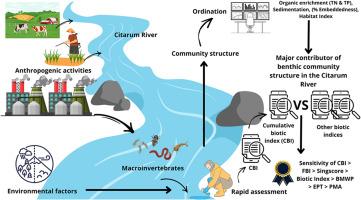Performance of the Cumulative Biotic Index (CBI) and other biotic indices in assessing ecological health of the Upper Citarum River, Indonesia
IF 8.7
Q1 Environmental Science
引用次数: 0
Abstract
The macroinvertebrate multimetric concept is widely employed to assess the ecological condition of freshwater ecosystems subjected to anthropogenic pressures. In this study, the Cumulative Biotic Index (CBI) was evaluated as a region-specific biocriteria-based tool to assess the ecological health of the Upper Citarum River, which has been heavily impacted by socioeconomic development. The objectives were to (1) assess the diversity and evenness of benthic macroinvertebrate communities, (2) identify key environmental factors influencing community structure, and (3) evaluate the sensitivity of the CBI in comparison with other established biological indices. Field surveys were conducted between September 2022 and August 2023 across 15 stations, applying rapid assessment protocols to measure water quality, habitat conditions, and benthic macroinvertebrate identifications. A total of 124 macroinvertebrate genera were identified, with diversity and evenness categorized as moderate to low (H’ = 2.6–0.3 nits) and stability ranging from medium to low (J = 0.75–0.27), indicating a decline at disturbed sites. Multivariate analyses revealed that organic enrichment (total nitrogen, total phosphorus), sedimentation (turbidity, percent embeddedness), and habitat disturbance (habitat index) were the primary factors shaping community composition. Among seven tested biological indices, the CBI demonstrated the highest sensitivity in distinguishing ecological gradients, underscoring its potential as a robust biomonitoring tool for evaluating restoration efforts in river ecosystems, particularly in Indonesia and other tropical rivers with similar conditions.

累积生物指数(CBI)和其他生物指数在印度尼西亚西塔鲁姆河上游生态健康评估中的表现
大型无脊椎动物多尺度概念被广泛用于评估淡水生态系统在人为压力下的生态状况。本研究将累积生物指数(CBI)作为一种基于区域特异性生物指标的工具来评估受社会经济发展严重影响的西塔鲁姆河上游生态健康状况。目的是:(1)评估底栖大型无脊椎动物群落的多样性和均匀性;(2)确定影响群落结构的关键环境因素;(3)与其他已建立的生物指标相比,评估CBI的敏感性。在2022年9月至2023年8月期间,在15个站点进行了实地调查,应用快速评估方案来测量水质、栖息地条件和底栖大型无脊椎动物的鉴定。共鉴定出124种大型无脊椎动物属,多样性和均匀度从中到低(H′= 2.6 ~ 0.3 nits),稳定性从中到低(J = 0.75 ~ 0.27),表明受干扰地点有所下降。多因素分析表明,有机富集(总氮、总磷)、沉积(浊度、嵌入率)和生境干扰(生境指数)是影响群落组成的主要因素。在七个测试的生物指数中,CBI在区分生态梯度方面表现出最高的敏感性,强调了其作为评估河流生态系统恢复工作的强大生物监测工具的潜力,特别是在印度尼西亚和其他具有类似条件的热带河流中。
本文章由计算机程序翻译,如有差异,请以英文原文为准。
求助全文
约1分钟内获得全文
求助全文
来源期刊

Water Cycle
Engineering-Engineering (miscellaneous)
CiteScore
9.20
自引率
0.00%
发文量
20
审稿时长
45 days
 求助内容:
求助内容: 应助结果提醒方式:
应助结果提醒方式:


